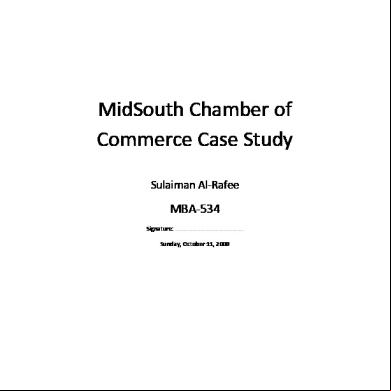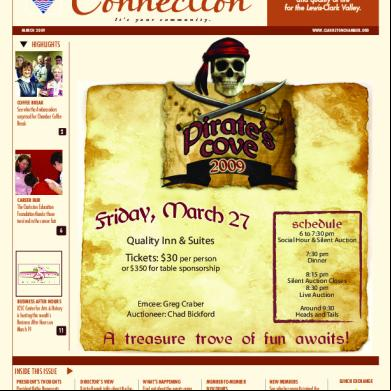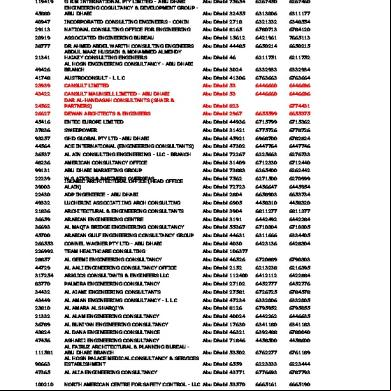Midsouth Chamber Of Commerce Case Study 10686i
This document was ed by and they confirmed that they have the permission to share it. If you are author or own the copyright of this book, please report to us by using this report form. Report 3b7i
Overview 3e4r5l
& View Midsouth Chamber Of Commerce Case Study as PDF for free.
More details w3441
- Words: 1,325
- Pages: 6
MidSouth Chamber of Commerce Case Study
Sulaiman Al‐Rafee
MBA‐534 Signature: ……………………………………… Sunday, October 11, 2009
Introduction Midsouth Chamber of Commerce (MSCC) was created to benefit of businesses within the Midsouth area. By the late 1980s, MSCC became the most powerful business advocacy organization within the area, with Jack Walingford as president. As they started using more and more computer technology, they recognized the need to use computer technology to harness the power of information they had. This case study outlines what MSCC went through when they acquired a new system to handle their operations.
Case summary Computer operations at MSCC MSCC had some computer systems that were not integrated, not documented, with little s and maintenance at the time, and the systems was not Y2K compatible. Leon Lassiter had a vision of an integrated computer system that could further help the organization in its core business (marketing, handling conferences and seminars, pushing the Legislature for new laws). They started with hiring a full‐time computer programmer (Simon Kovecki), and started looking at software packages for the organization. While Lassiter was not in charge of computer operations (Jeff Hedges was put in charge of computer operations), Lassiter pushed the organization to purchase a new system from a company called UNITRAK. It seemed like Lassiter was the “champion” behind the software, there was little or no from the people who were in charge. Employees where concerned that they were not consulted, and Kovecki (who was frustrated because he didn't get the promotion to be head of computer operations) raised concerns regarding the fact that employees had access to all of the data. Hedges (in charge of computer operations, but was mainly busy with other aspects of the
organization) had no computer expertise, and never followed up on the status of the system purchase/use.
The new system Lassiter thought that the new system from UNITRAK was powerful enough to provide MSCC with future growth. After convincing the board with a demonstration, the system was eventually purchased (championed by Lassiter). There were delays with the purchase, with Lassiter pushing for the purchase/use of the system. After the system was purchased, Kovecki (who was busy with other projects) stalled on the application of the system. The project was late, and s and staff started asking questions about the new system (no one asked them for input from the beginning). Lassiter pushed for a two day training session for the system, to be undertaken with UNITRAK employees. Staff which attended the session thought that the system was not as functional and as ‐friendly as the old system. Lassiter, however, thought that this was normal since this is a new system. The next step was the implementation. In order to use the system, the old data have to be converted to the new system. Kovecki had problems with converting the data, some of the data was corrupted, and to make things worse, there were problems with the backups resulting in data being lost. Hedges was busy with his work at the organization, he never paid attention to the new system. And Lassiter could not force Kovecki to work on the system and to finish it because Kovecki did not report to him. Lassiter was worried because the system was already six months late, some of the data was corrupted, and the organization had to worry about the Y2K problem (coming up within few months).
Problems/Issues The person in charge of the new system, was not in a position to be in charge of the system Cause: Hedges was too busy to be in charge of the new system, and Kovecki was upset because he didn’t get the promotion, so he wasn’t motivated. Lassiter was not in charge of computer operations, but he was the one pushing the new system. The case also mentions “No ” from higher management/the board. Solution/Learned Lesson: Someone with IT knowledge should head computer operations, and IT should be his/her only focus. Also, one should get the acceptance/approval/ of all of the major players in an organization before implementing a new system. This is of at most importance, especially for an organization that relies heavily on information. Lack of experience and motivation of the computer personnel/department Cause: Kovecki had no experience (he was a fresh graduate), and he was disgruntled because he didn’t get the promotion he wanted. He was also taking a long time in getting started with the new system, and there was no one (Hedges was too busy) to watch over him. Hedges (who was in charge of computer operations) also had no IT experience. Solution/Learned Lesson: An organization that depends heavily on information, must have the right person watching/controlling its most precious asset (information). The system wasn’t easy to use, and didn’t have as many functions as the old system Cause: None of the staff (who will eventually be the s) was consulted or asked to participate in deg the new system. Solution/Learned Lesson: Need to get staff involvement in the design of a system.
The data was lost and corrupted after the conversion to the new system Cause: No documentation was available for the old system, and the last backup was done more than 3 months ago. Any computer knows that backups are essential in any organization. Solution/Learned Lesson: Make sure that all of your software is well documented, and that backups are continuously done (and tested also). Y2K Cause: The current system was not Y2K compatible Solution/Learned Lesson: You shouldn’t wait for the last minute to update your systems Data Consistency Cause: The current system was based on separate databases (where the same data had to be updated on all systems) Solution/Learned Lesson: Systems should use an integrated database, this would allow for more accurate/efficient data entry Software Cause: When MSCC was having problems with the data conversion, UNITRAK was not providing any help with the conversion Solution/Learned Lesson: Make sure to get an organization that would provide reliable in case of problems with the purchased systems. They should also make sure that any system they purchase is well known and is in use within an industry (the UNITRAK system was only used by one other organization only)
Action In my opinion, Lassiter should do the following:
‐
Get the full from top management and the board for the new system (he has to sell them the idea).
‐
Create a team/IT department that would be in charge of the conversion for the data, and the use of the new system.
‐
Remove computer operations from Hedges (he has no IT experience, and wasn’t paying enough attention to it), and create an IT department was someone with IT knowledge can head it (with staff).
‐
Require UNITRAK to provide better with the conversion, and make sure all of their requests and are met accordingly. Make sure that MSCC has adequate documentation about the new system (they don’t want to make the same mistake twice)
‐
Insure that the organization has a well backup plan for all systems
‐
Fire Kovecki! He didn’t have experience, wasn’t motivated, was disgruntled, wasn’t good at his job (lack of backup), and lazy.
‐
Hire an outside consultant to help make the old system Y2K compatible (backup plan, in case the new system’s data conversion and use isn’t finished by the end of the year).
Conclusion MSCC is one organization that depends almost entirely on the data and information they have within their computer systems. This was a case of not protecting your most important asset, and I wouldn’t be surprised if the organization had gone bankrupt the following year (with the mounting expenses). While introducing a new system into an organization isn’t always easy, it would seem like MSCC wasn’t prepared for the all of the problems they encountered.
Sulaiman Al‐Rafee
MBA‐534 Signature: ……………………………………… Sunday, October 11, 2009
Introduction Midsouth Chamber of Commerce (MSCC) was created to benefit of businesses within the Midsouth area. By the late 1980s, MSCC became the most powerful business advocacy organization within the area, with Jack Walingford as president. As they started using more and more computer technology, they recognized the need to use computer technology to harness the power of information they had. This case study outlines what MSCC went through when they acquired a new system to handle their operations.
Case summary Computer operations at MSCC MSCC had some computer systems that were not integrated, not documented, with little s and maintenance at the time, and the systems was not Y2K compatible. Leon Lassiter had a vision of an integrated computer system that could further help the organization in its core business (marketing, handling conferences and seminars, pushing the Legislature for new laws). They started with hiring a full‐time computer programmer (Simon Kovecki), and started looking at software packages for the organization. While Lassiter was not in charge of computer operations (Jeff Hedges was put in charge of computer operations), Lassiter pushed the organization to purchase a new system from a company called UNITRAK. It seemed like Lassiter was the “champion” behind the software, there was little or no from the people who were in charge. Employees where concerned that they were not consulted, and Kovecki (who was frustrated because he didn't get the promotion to be head of computer operations) raised concerns regarding the fact that employees had access to all of the data. Hedges (in charge of computer operations, but was mainly busy with other aspects of the
organization) had no computer expertise, and never followed up on the status of the system purchase/use.
The new system Lassiter thought that the new system from UNITRAK was powerful enough to provide MSCC with future growth. After convincing the board with a demonstration, the system was eventually purchased (championed by Lassiter). There were delays with the purchase, with Lassiter pushing for the purchase/use of the system. After the system was purchased, Kovecki (who was busy with other projects) stalled on the application of the system. The project was late, and s and staff started asking questions about the new system (no one asked them for input from the beginning). Lassiter pushed for a two day training session for the system, to be undertaken with UNITRAK employees. Staff which attended the session thought that the system was not as functional and as ‐friendly as the old system. Lassiter, however, thought that this was normal since this is a new system. The next step was the implementation. In order to use the system, the old data have to be converted to the new system. Kovecki had problems with converting the data, some of the data was corrupted, and to make things worse, there were problems with the backups resulting in data being lost. Hedges was busy with his work at the organization, he never paid attention to the new system. And Lassiter could not force Kovecki to work on the system and to finish it because Kovecki did not report to him. Lassiter was worried because the system was already six months late, some of the data was corrupted, and the organization had to worry about the Y2K problem (coming up within few months).
Problems/Issues The person in charge of the new system, was not in a position to be in charge of the system Cause: Hedges was too busy to be in charge of the new system, and Kovecki was upset because he didn’t get the promotion, so he wasn’t motivated. Lassiter was not in charge of computer operations, but he was the one pushing the new system. The case also mentions “No ” from higher management/the board. Solution/Learned Lesson: Someone with IT knowledge should head computer operations, and IT should be his/her only focus. Also, one should get the acceptance/approval/ of all of the major players in an organization before implementing a new system. This is of at most importance, especially for an organization that relies heavily on information. Lack of experience and motivation of the computer personnel/department Cause: Kovecki had no experience (he was a fresh graduate), and he was disgruntled because he didn’t get the promotion he wanted. He was also taking a long time in getting started with the new system, and there was no one (Hedges was too busy) to watch over him. Hedges (who was in charge of computer operations) also had no IT experience. Solution/Learned Lesson: An organization that depends heavily on information, must have the right person watching/controlling its most precious asset (information). The system wasn’t easy to use, and didn’t have as many functions as the old system Cause: None of the staff (who will eventually be the s) was consulted or asked to participate in deg the new system. Solution/Learned Lesson: Need to get staff involvement in the design of a system.
The data was lost and corrupted after the conversion to the new system Cause: No documentation was available for the old system, and the last backup was done more than 3 months ago. Any computer knows that backups are essential in any organization. Solution/Learned Lesson: Make sure that all of your software is well documented, and that backups are continuously done (and tested also). Y2K Cause: The current system was not Y2K compatible Solution/Learned Lesson: You shouldn’t wait for the last minute to update your systems Data Consistency Cause: The current system was based on separate databases (where the same data had to be updated on all systems) Solution/Learned Lesson: Systems should use an integrated database, this would allow for more accurate/efficient data entry Software Cause: When MSCC was having problems with the data conversion, UNITRAK was not providing any help with the conversion Solution/Learned Lesson: Make sure to get an organization that would provide reliable in case of problems with the purchased systems. They should also make sure that any system they purchase is well known and is in use within an industry (the UNITRAK system was only used by one other organization only)
Action In my opinion, Lassiter should do the following:
‐
Get the full from top management and the board for the new system (he has to sell them the idea).
‐
Create a team/IT department that would be in charge of the conversion for the data, and the use of the new system.
‐
Remove computer operations from Hedges (he has no IT experience, and wasn’t paying enough attention to it), and create an IT department was someone with IT knowledge can head it (with staff).
‐
Require UNITRAK to provide better with the conversion, and make sure all of their requests and are met accordingly. Make sure that MSCC has adequate documentation about the new system (they don’t want to make the same mistake twice)
‐
Insure that the organization has a well backup plan for all systems
‐
Fire Kovecki! He didn’t have experience, wasn’t motivated, was disgruntled, wasn’t good at his job (lack of backup), and lazy.
‐
Hire an outside consultant to help make the old system Y2K compatible (backup plan, in case the new system’s data conversion and use isn’t finished by the end of the year).
Conclusion MSCC is one organization that depends almost entirely on the data and information they have within their computer systems. This was a case of not protecting your most important asset, and I wouldn’t be surprised if the organization had gone bankrupt the following year (with the mounting expenses). While introducing a new system into an organization isn’t always easy, it would seem like MSCC wasn’t prepared for the all of the problems they encountered.










